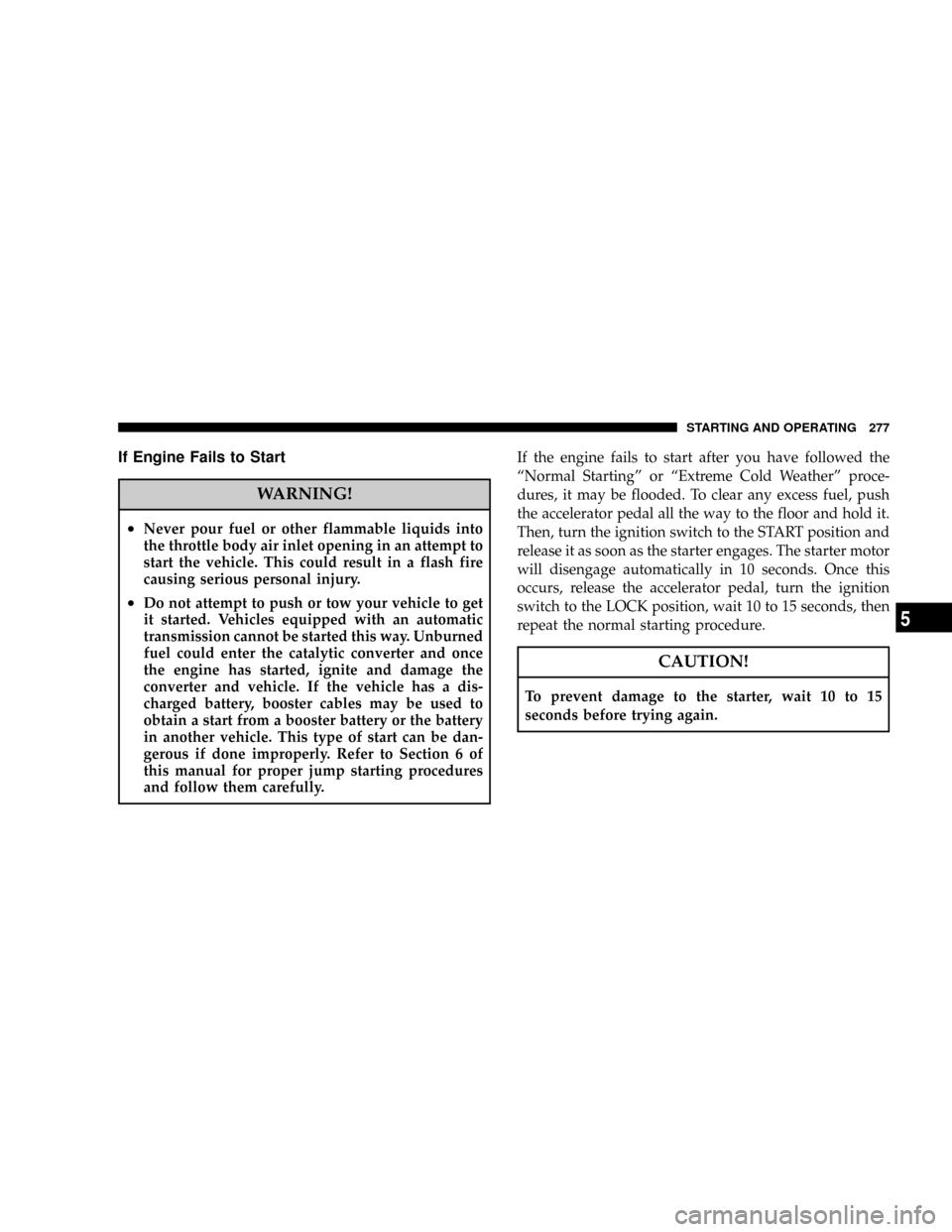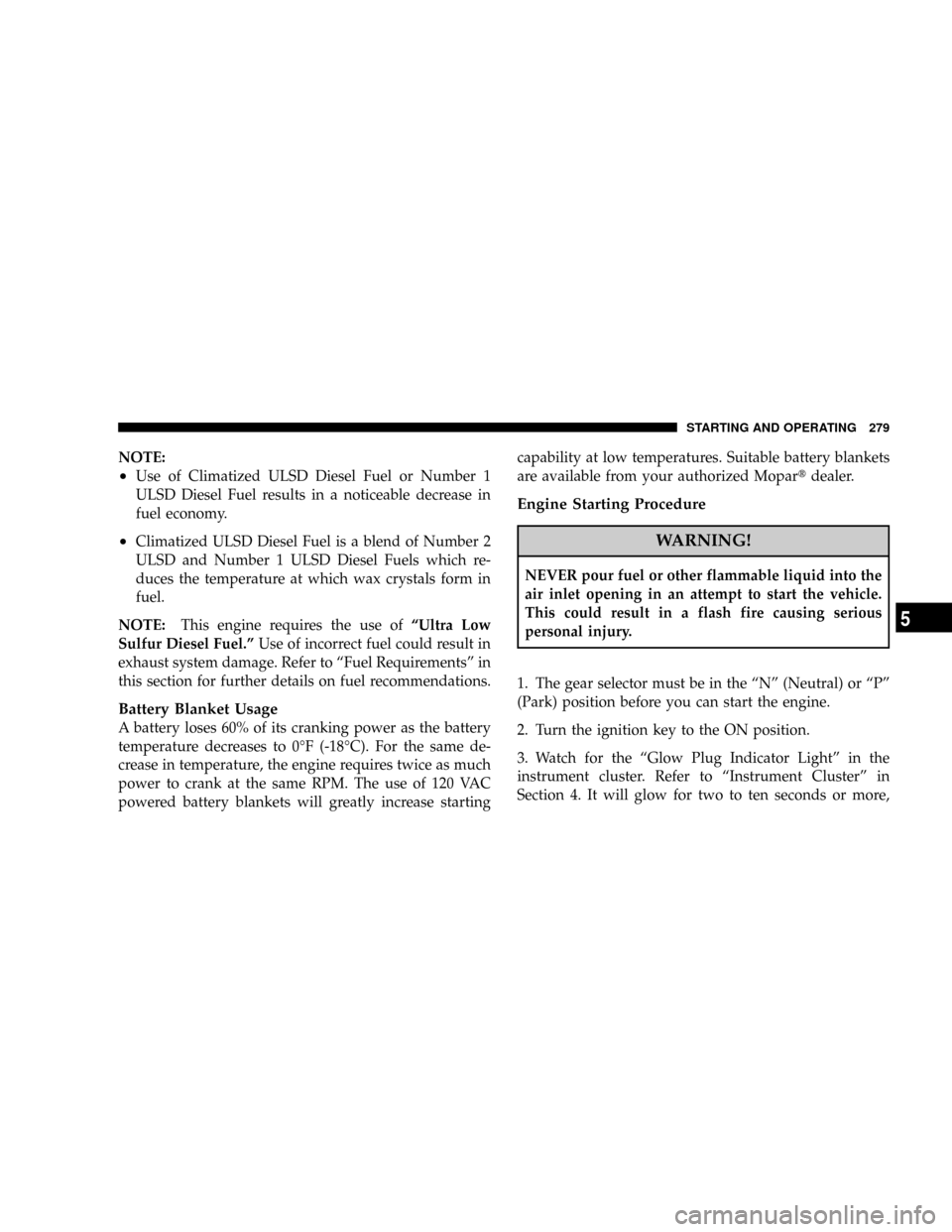JEEP GRAND CHEROKEE 2008 WK / 3.G Owners Manual
Manufacturer: JEEP, Model Year: 2008, Model line: GRAND CHEROKEE, Model: JEEP GRAND CHEROKEE 2008 WK / 3.GPages: 490, PDF Size: 6.86 MB
Page 271 of 490

STARTING AND OPERATING
CONTENTS
mStarting Procedure......................275
NNormal Starting Ð Gasoline Engines.......276
NExtremely Cold Weather (Below220ÉF Or
229ÉC).............................276
NIf Engine Fails To Start.................277
NAfter Starting........................278
NNormal Starting Ð Diesel Engines.........278
mEngine Block Heater Ð If Equipped.........283
mAutomatic Transmission..................284NShift Lock Manual Override Ð If Equipped . . . 284
NBrake/Transmission Interlock System.......285
N5±Speed Automatic Transmission..........285
NGear Ranges.........................286
NRocking The Vehicle...................292
mFour-Wheel Drive Operation...............293
NQuadra-Trac ItOperating Instructions/
Precautions Ð If Equipped..............293
NQuadra-Trac IItOperating
Instructions/Precautions Ð If Equipped.....293
5
Page 272 of 490

NShift Positions........................295
NShifting Procedures....................296
NQuadra-Drive IItSystem Ð If Equipped.....299
mOn-Road Driving Tips...................299
mOff-Road Driving Tips...................300
NWhen To Use 4WD Low Range Ð
If Equipped.........................300
NDriving Through Water.................300
NDriving In Snow, Mud And Sand..........301
NHill Climbing........................301
NTraction Downhill.....................302
NAfter Driving Off-Road.................303
mParking Brake.........................304mAnti-Lock Brake System..................305
mPower Steering........................308
mMulti Displacement System (MDS) Ð 5.7L Engine
Only................................309
mTire Safety Information...................310
NTire Markings........................310
NTire Identification Number (TIN)..........313
NTire Loading And Tire Pressure...........314
mTires Ð General Information...............318
NTire Pressure.........................318
NTire Inflation Pressures.................319
NTire Pressures For High Speed Operation....321
NRadial-Ply Tires......................321
272 STARTING AND OPERATING
Page 273 of 490

NTire Spinning........................321
NTread Wear Indicators..................322
NLife Of Tire.........................323
NReplacement Tires.....................323
NAlignment And Balance.................324
mTire Chains...........................325
mTire Rotation Recommendations............325
mTire Pressure Monitor System (TPMS)........326
NBase System Ð If Equipped..............329
NPremium System Ð If Equipped..........331
NGeneral Information...................336
mFuel Requirements......................336
N3.7/4.7L Engines (If Equipped)............336N5.7L Engines (If Equipped)...............337
NReformulated Gasoline.................337
NGasoline/Oxygenate Blends..............338
NMMT In Gasoline.....................338
NMaterials Added To Fuel................339
NFuel System Cautions..................339
NCarbon Monoxide Warnings..............340
mFlexible Fuel (4.7L Engine Only) Ð
If Equipped...........................340
NE-85 General Information................340
NEthanol Fuel (E-85)....................341
NFuel Requirements....................342
NSelection Of Engine Oil For Flexible Fuel
Vehicles (E-85) And Gasoline Vehicles.......343
STARTING AND OPERATING 273
5
Page 274 of 490

NStarting............................343
NCruising Range.......................343
NReplacement Parts.....................343
mFuel Requirements (Diesel Engines)..........344
mAdding Fuel..........................345
NFuel Filler Cap (Gas Cap)...............346
mVehicle Loading........................348
NCertification Label.....................348
mTrailer Towing.........................351
NCommon Towing Definitions.............351
NTrailer Hitch Classification...............354NTrailer Towing Weights (Maximum Trailer
Weight Ratings)......................355
NTrailer And Tongue Weight..............357
NTowing Requirements..................358
NTowing Tips.........................362
mRecreational Towing (Behind Motorhome, Etc.) . . 364
NTowing ± 2WD Models.................364
NTowing Ð Quadra-Trac I (Single-Speed Transfer
Case) 4WD Models....................364
NTowing Ð Quadra±Trac II /Quadra±Drive II
4WD Models........................364
mSnow Plow...........................368
274 STARTING AND OPERATING
Page 275 of 490

STARTING PROCEDURE
Before starting your vehicle, adjust your seat, adjust the
inside and outside mirrors, fasten your seat belt, and if
present, instruct all other occupants to buckle their seat
belts.WARNING!
²Never leave children alone in a vehicle. Leaving
children in a vehicle unattended is dangerous
for a number of reasons. A child or others could
be seriously or fatally injured. Don't leave the
keys in the ignition. A child could operate power
windows, other controls, or move the vehicle.
²Do not leave animals or children inside parked
vehicles in hot weather; interior heat build up
may cause serious injury or death.
²Be sure to turn off the engine and remove the
key from the ignition switch if you want to rest
or sleep in your car. Accidents can be caused by
inadvertently moving the gear selection lever.
Accidents can also be caused by pressing the
accelerator pedal. This may cause excessive heat
in the exhaust system, resulting in overheating
and vehicle fire, which may cause serious or
fatal injuries.
STARTING AND OPERATING 275
5
Page 276 of 490

Normal Starting Ð Gasoline Engines
The gear selector must be in the ªNº (Neutral) or ªPº
(Park) position before you can start the engine. Apply the
brakes before shifting into any driving gear.
NOTE:Normal starting of either a cold or a warm
engine is obtained without pumping or depressing the
accelerator pedal.
Do notpress the accelerator. Use the Fob with Integrated
Key to briefly turn the ignition switch to the START
position and release it as soon as the starter engages. Thestarter motor will continue to run, and it will disengage
automatically when the engine is running. If the engine
fails to start, the starter will disengage automatically in 10
seconds. If this occurs, turn the ignition switch to the
LOCK position, wait 10 to 15 seconds, then repeat the
normal starting procedure.
Extremely Cold Weather (below220ÉF or229ÉC)
To insure reliable starting at these temperatures, use of an
externally powered electric engine block heater (available
from your dealer) is recommended.
276 STARTING AND OPERATING
Page 277 of 490

If Engine Fails to Start
WARNING!
²Never pour fuel or other flammable liquids into
the throttle body air inlet opening in an attempt to
start the vehicle. This could result in a flash fire
causing serious personal injury.
²Do not attempt to push or tow your vehicle to get
it started. Vehicles equipped with an automatic
transmission cannot be started this way. Unburned
fuel could enter the catalytic converter and once
the engine has started, ignite and damage the
converter and vehicle. If the vehicle has a dis-
charged battery, booster cables may be used to
obtain a start from a booster battery or the battery
in another vehicle. This type of start can be dan-
gerous if done improperly. Refer to Section 6 of
this manual for proper jump starting procedures
and follow them carefully.If the engine fails to start after you have followed the
ªNormal Startingº or ªExtreme Cold Weatherº proce-
dures, it may be flooded. To clear any excess fuel, push
the accelerator pedal all the way to the floor and hold it.
Then, turn the ignition switch to the START position and
release it as soon as the starter engages. The starter motor
will disengage automatically in 10 seconds. Once this
occurs, release the accelerator pedal, turn the ignition
switch to the LOCK position, wait 10 to 15 seconds, then
repeat the normal starting procedure.
CAUTION!
To prevent damage to the starter, wait 10 to 15
seconds before trying again.
STARTING AND OPERATING 277
5
Page 278 of 490

After Starting
The idle speed is controlled automatically and it will
decrease as the engine warms up.
Normal Starting Ð Diesel Engines
Observe the following when the engine is operating.
²All message center lights are off.
²Malfunction Indicator Light (MIL) is off.
²Low Oil Pressure Light is off.
Cold Weather Precautions
Operation in ambient temperature below 32ÉF (0ÉC) may
require special considerations. The following chart sug-
gest these options:
*No. 1 Ultra Low Sulfur Diesel Fuel (ULSD) should only
be used where extended arctic conditions (-10ÉF/-23ÉC)
exist.
278 STARTING AND OPERATING
Page 279 of 490

NOTE:
²Use of Climatized ULSD Diesel Fuel or Number 1
ULSD Diesel Fuel results in a noticeable decrease in
fuel economy.
²Climatized ULSD Diesel Fuel is a blend of Number 2
ULSD and Number 1 ULSD Diesel Fuels which re-
duces the temperature at which wax crystals form in
fuel.
NOTE:This engine requires the use ofªUltra Low
Sulfur Diesel Fuel.ºUse of incorrect fuel could result in
exhaust system damage. Refer to ªFuel Requirementsº in
this section for further details on fuel recommendations.
Battery Blanket Usage
A battery loses 60% of its cranking power as the battery
temperature decreases to 0ÉF (-18ÉC). For the same de-
crease in temperature, the engine requires twice as much
power to crank at the same RPM. The use of 120 VAC
powered battery blankets will greatly increase startingcapability at low temperatures. Suitable battery blankets
are available from your authorized Mopartdealer.
Engine Starting Procedure
WARNING!
NEVER pour fuel or other flammable liquid into the
air inlet opening in an attempt to start the vehicle.
This could result in a flash fire causing serious
personal injury.
1. The gear selector must be in the ªNº (Neutral) or ªPº
(Park) position before you can start the engine.
2. Turn the ignition key to the ON position.
3. Watch for the ªGlow Plug Indicator Lightº in the
instrument cluster. Refer to ªInstrument Clusterº in
Section 4. It will glow for two to ten seconds or more,
STARTING AND OPERATING 279
5
Page 280 of 490

depending on engine temperature. When the ªGlow Plug
Indicator Lightº goes out, the engine is ready to start.
4. Tip Start Feature
Do notpress the accelerator. Use the Fob with Integrated
Key to briefly turn the ignition switch to the START
position and then release it. The starter motor will
continue to run, and it will automatically disengage
when the engine is running.
NOTE:The starter motor may run up to 30 seconds in
very cold conditions until the engine is started. The
starter can be disengaged by turning the ignition key to
the OFF position, if required.
5. After the engine starts, allow it to idle for approxi-
mately 30 seconds before driving. This allows oil to
circulate and lubricate the turbocharger.
Avoid prolonged idling in ambient temperatures below
0ÉF (-18ÉC). Long periods of idling may be harmful toyour engine because combustion chamber temperatures
can drop so low that the fuel may not burn completely.
Incomplete combustion allows carbon and varnish to
form on piston rings and injector nozzles. Also, the
unburned fuel can enter the crankcase, diluting the oil
and causing rapid wear to the engine.
Engine Warm-Up
Avoid full throttle operation when the engine is cold.
When starting a cold engine, bring the engine up to
operating speed slowly to allow the oil pressure to
stabilize as the engine warms up.
NOTE:High-speed, no-load running of a cold engine
can result in excessive white smoke and poor engine
performance. No-load engine speeds should be kept
under 1,200 rpm during the warm-up period, especially
in cold ambient temperature conditions.
280 STARTING AND OPERATING